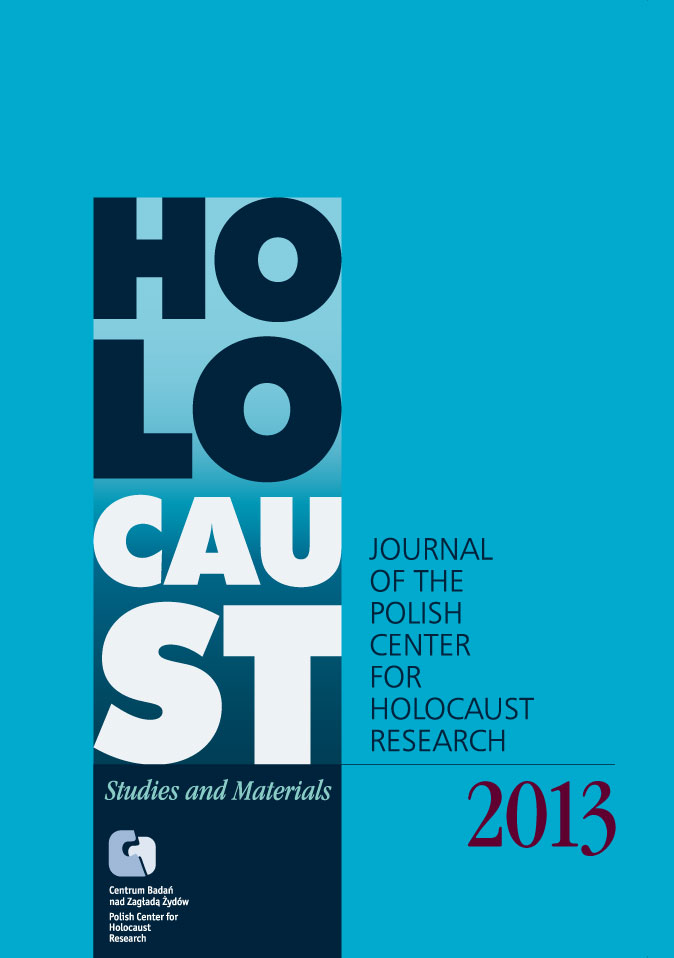Gone but not Forgotten: Archaeological approaches to the site of the former Treblinka Extermination Camp in Poland
Zagłada Żydów. Studia i Materiały, Nr Holocaust Studies and Materials (2013), Strony: 253-289
Data zgłoszenia: 2020-12-13Data publikacji: 2013-02-20
 https://doi.org/10.32927/zzsim.809
https://doi.org/10.32927/zzsim.809
Abstrakt
Public impression of the Holocaust is unquestionably centred on knowledge about, and the image of, Auschwitz-Birkenau – the gas chambers, the crematoria, the systematic and industrialized killing of victims. Conversely, knowledge of the former extermination camp at Treblinka, which stands in stark contrast in terms of the visible evidence that survives pertaining to it, is less embedded in general public consciousness. As this paper argues, the contrasting level of knowledge about Auschwitz-Birkenau and Treblinka is centred upon the belief that physical evidence of the camps only survives when it is visible and above-ground. The perception of Treblinka as having been “destroyed” by the Nazis, and the belief that the bodies of all of the victims were cremated without trace, has resulted in a lack of investigation aimed at answering questions about the extent and nature of the camp, and the locations of mass graves and cremation pits. This paper discusses the evidence that demonstrates that traces of the camp do survive. It outlines how archival research and non-invasive archaeological survey has been used to re-evaluate the physical evidence pertaining to Treblinka in a way that respects Jewish Halacha Law. As well as facilitating spatial and temporal analysis of the former extermination camp, this survey has also revealed information about the cultural memory associated with the site and how much has been forgotten about its history.
Licencja
Prawa autorskie (c) 2013 Autor&"Zagłada Żydów. Studia i Materiały"

Utwór dostępny jest na licencji Creative Commons Uznanie autorstwa 4.0 Międzynarodowe.
https://creativecommons.org/licenses/by/4.0
Czasopismo publikowane jest w standardzie Diamond Open Access na licencji CC-BY-4.0 Deed - Uznanie autorstwa 4.0 Międzynarodowa - Creative Commons
Inne teksty tego samego autora
- Caroline Sturdy Colls, O tym, co minęło, lecz nie zostało zapomniane: Badania archeologiczne na terenie byłego obozu zagłady w Treblince , Zagłada Żydów. Studia i Materiały: Nr 8 (2012)
Podobne artykuły
- Maria Ferenc-Piotrowska, „Czarna, ogromna chmura wisi nad nami i na pewno spadnie…” Żydzi w miastach i miasteczkach Generalnego Gubernatorstwa wobec wiadomości o akcji „Reinhardt” , Zagłada Żydów. Studia i Materiały: Nr 13 (2017)
- Agnieszka Haska, Arnon Rubin, Facts and Fictions about the Rescue of the Polish Jewry during the Holocaust , Zagłada Żydów. Studia i Materiały: Nr 3 (2007)
- Katarzyna Person, Mówi Jürgen Stroop. Proces likwidatora powstania w getcie warszawskim przed Sądem Wojewódzkim w Warszawie , Zagłada Żydów. Studia i Materiały: Nr 9 (2013)
- Anna Ziółkowska, Medycyna obozowa. O tym jak chorowali, cierpieli i umierali żydowscy robotnicy w obozach pracy przymusowej w Poznaniu (1941–1943) , Zagłada Żydów. Studia i Materiały: Nr 8 (2012)
- Luiza Nader, Pamiętanie afektywne. Moim przyjaciołom Żydom Władysława Strzemińskiego , Zagłada Żydów. Studia i Materiały: Nr 8 (2012)
- Piotr Forecki, Książki pod specjalnym nadzorem [Mirosław Tryczyk, Miasta śmierci i Drzazga; Paweł Piotr Reszka, Płuczki] , Zagłada Żydów. Studia i Materiały: Nr 17 (2021)
- Zuzanna Schnepf-Kołacz, „Write your story” – seria wydawnicza Makor Jewish Community Library , Zagłada Żydów. Studia i Materiały: Nr 3 (2007)
- Marcin Kula, Szuflada z dokumentami [Czarna księga, red. Wasilij Grossman, Ilja Erenburg, oprac. Joanna Nalewajko-Kulikov] , Zagłada Żydów. Studia i Materiały: Nr 17 (2021)
- Łukasz Krzyżanowski, Monika Rice, „What! Still Alive?!” Jewish Survivors in Poland and Israel Remember Homecoming, Syracuse: Syracuse University Press, 2017, 254 s. , Zagłada Żydów. Studia i Materiały: Nr 14 (2018)
- Dariusz Libionka, Apokryfy z dziejów Żydowskiego Związku Wojskowego i ich autorzy. , Zagłada Żydów. Studia i Materiały: Nr 1 (2005)
<< < 1 2 3 4 5 6 7 8 9 10 11 12 13 14 15 16 17 18 19 20 21 22 23 24 25 26 27 28 29 30 31 32 33 34 35 36 37 38 39 40 41 42 43 44 45 46 47 48 49 50 > >>
Możesz również Rozpocznij zaawansowane wyszukiwanie podobieństw dla tego artykułu.
 English
English
 Język Polski
Język Polski




